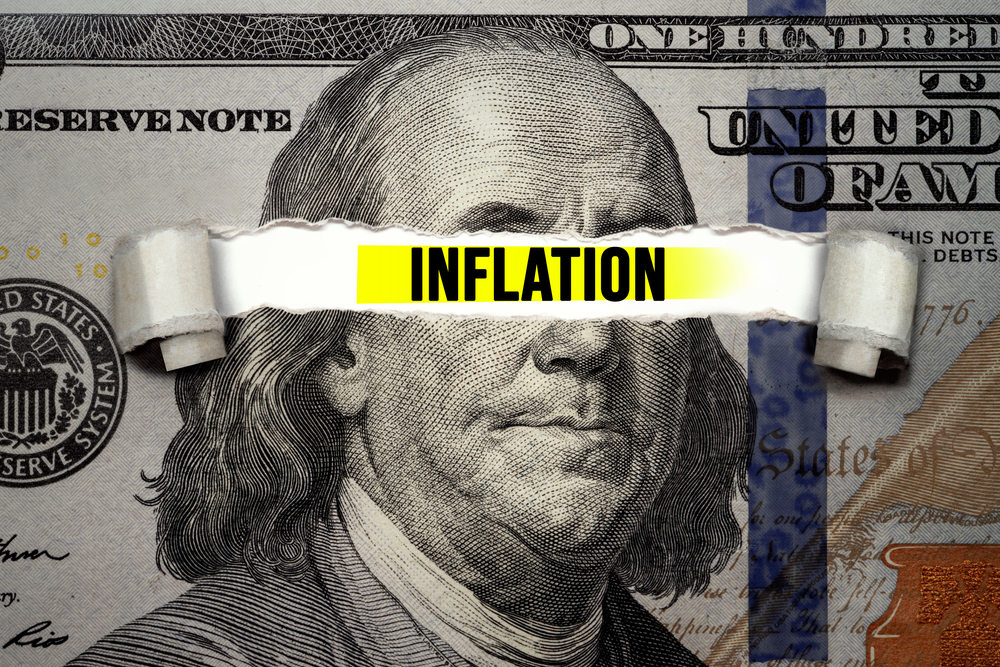Economy
It’s The Demand Curve, Stupid…

It’s The Demand Curve, Stupid…
By Christopher Thornberg
The biggest obstacle to slowing inflation is that the real causes of it—excessive consumer demand and rapidly rising wages—are too politically toxic to acknowledge.
The August CPI report showed prices in the United States continuing to increase, contrary to the predictions of most Blue-Chip forecasts and the Federal Reserve. This has spooked the markets and caused a sharp decline in the various indexes—the S&P 500 dropped over 4%. The decline in the markets doesn’t surprise me—they are the ultimate drama queens of the economy, overreacting to everything. They will likely bounce back soon enough.
What does perplex me is how we collectively continue to be surprised when the official inflation forecasts fall well below reality. This same kabuki dance has been repeated almost monthly for more than a year now, with expert economists assuring us that price growth will soon decelerate and maybe even reverse, followed by a gnashing of teeth and predictions of doom when it turns out the data is not living up to the optimism.
I am certainly not suggesting that inflation is easy to forecast—especially on a month-to-month basis. But the problem I see here is different. The major forecasts and official prognostications aren’t just missing the mark, they have consistently predicted lower inflation rates than have been occurring. In statistical parlance the forecasts have bias. And this bias stems from the fact that the cause of inflation has been misinterpreted as primarily a supply chain issue, when in fact it is an excess demand and labor cost issue.
Consider the various explanations for inflation over the last year. They have typically attributed the problem to parts shortages (e.g., empty car dealer lots and high used-car prices), energy markets (the high cost of gasoline), the war in Ukraine and grain markets (food prices) among other issues. The following quote is from a Wall Street Journal reporter discussing her interviews with various economists prior to the summer CPI estimates:
“[June] will probably prove to be the peak for the annual measure of CPI. That’s because pretty much all of the major drivers of the inflation surge this year and last year are fading or outright reversing. Energy prices are on the downswing, most obviously gasoline prices. Upstream, energy and food commodity prices have come down a lot in recent weeks too, which suggests that there’s more easing to feed through to consumers in store, particularly on the grocery front. Supply-chain pressures seem to be gradually improving.”[1]
If we think about inflation as being strictly driven by limitations in inputs, then any relief in those supply pressures should cause prices to fall. But this is not the case today, as the August number clearly demonstrates. The supply-chain theory of inflation is wrong. And the reason many experts continue to get it wrong is because the true causes of today’s inflation—excess consumer demand and rapidly rising labor costs—are politically toxic and difficult to acknowledge in these terse populist times.
Excess consumer demand has been caused by an overstimulation of the economy on the part of the Feds. As I have written many times, the pandemic hit to the economy was never the crisis it was portrayed to be, and the $6.5 trillion in fiscal stimulus, largely funded by $5 trillion in new money created through the Fed’s quantitative easing program, was vastly more than necessary. It set financial markets to new (unsustainable) highs and ultimately generated a 25% bump in household net worth ($30 trillion in new wealth) in just 2 years. This new “wealth” has driven consumer spending to new highs, and that is what is causing inflation. As Milton Friedman famously quipped: “Inflation is caused by too much money chasing after too few goods.”
Looking at the supply side only mistakes the symptoms for the disease. Gasoline prices shot up because the minor issues with supply were magnified by the major jump in demand. Estimates of short-run demand elasticity for gasoline suggest the market is inelastic, but still, an increase in price will lead to a decrease in consumption if those prices are only being driven by supply constraints. Yet, the Bureau of Economic Analysis’ GDP data shows that in the last 18 months, even as energy prices rose 97%, consumption of energy products increased by 7%. Prices rose so dramatically because of the surge in demand, not the limitations on supply.
And now that energy prices are falling as supply catches up, money not spent on energy is simply flowing to other spending—healthcare, housing, restaurants, travel—and causing more inflation in those categories. And those sectors also have supply shortages—driven by labor shortages rather than supply chain issues. Just as excess demand drove up energy prices, excess demand is also causing a rapid increase in worker earnings, which is another important contributor to business costs and output prices. According to the Atlanta Fed’s wage tracker, U.S. worker earnings are now growing at a 6.7% annual pace—the highest rate ever recorded in the 40 years of data they have created.
And therein lies the political problem. If we acknowledge that inflation is being driven by excessive consumer demand, then we must admit that Americans are overconsuming. That’s an idea that doesn’t fit the miserabilist narrative that underpins political debate today. Both parties consistently tell their supporters how terrible they have it and then immediately blame the other party’s policies. Apparently, in the political world, most U.S. households are living hand to mouth, workers are highly underpaid, and we’re all just one paycheck away from financial disaster. To suggest otherwise would be gauche.
For the record, U.S. consumers are overconsuming. Consumer spending as a share of nation’s GDP is the highest it’s ever been, except during the runup to the Great Recession—not a comfortable comparison. This overconsumption is one of the root causes of the growing U.S. trade deficit, currently at almost 5% of GDP, again the widest it’s ever been except for the 2005 and 2006 period. As for the idea that real earnings growth is negative, you only get this result if you use the CPI estimate of inflation, which overstates the situation for technical reasons we won’t dive into here.[2] The appropriate deflator is the PCE deflator from the Bureau of Economic Analysis, and if we use that, real earnings growth is positive, albeit not at a 40-year high pace.
Of course, this story is only explaining the mechanisms within basic monetary theory. If you want to predict how much prices will increase, you only need to look at money supply. The Federal Reserve’s quantitative easing program expanded the money supply of the United States by 40%. Therefore, holding all else constant, prices need to go up by 40% to equilibrate the size of the economy to the size of the money supply.
While the Fed’s quantitative easing caused inflation, oddly their response to the problem has been primarily to push up the Federal Funds rate, the old tool that Ben Bernanke had largely moved past during his tenure. The big hikes in the Federal Funds rate have done very little to reduce the money supply; it has only stopped growing. If the Fed is serious about slowing inflation, they need to engage in quantitative tightening—which they say they will be starting this month.
By tightening of course, they will, by definition, cool consumer demand and weaken labor markets, as these are the ultimate sources of inflation. Given that policymakers are seemingly unwilling to acknowledge that the problem is excessive spending as well as wage growth, it unfortunately suggests they will be unwilling to do what is necessary to slow inflation.
The only question then is how much longer will we continue to be surprised by it.
2 For more about the CPI’s inflation estimate see: https://www.clevelandfed.org/newsroom-and-events/publications/economic-trends/2014-economic-trends/et-20140417-pce-and-cpi-inflation-whats-the-difference.aspx
Business
Economist Christopher Thornberg, State Treasurer Fiona Ma Headline New Forecast Conference

Coming October 5th
Economic Horizon 2024: What Lies Ahead?
The Inland Empire Regional Chamber of Commerce, in collaboration with Beacon Economics and the County of San Bernardino, is thrilled to announce that the anticipated economic forecast conference, Economic Horizon 2024: What Lies Ahead, Inland Empire? will be held October 5th from 3:30 PM to 6:30 PM at the El Prado Golf Courses in the vibrant city of Chino, California.
Esteemed economist, Dr. Christopher Thornberg will present complete outlooks for the U.S., California, and Inland Empire economies. “The Inland Empire stands at the crossroads of remarkable economic opportunities and challenges,” said Thornberg. “I’m excited to unpack the trends and shifts that will define the region’s economic landscape in the next year, and beyond.”
Known for his razor-sharp observations, and fun, energized delivery, Thornberg’s presentation will include pointed discussions about inflation, the Fed’s next move, housing markets, strengths and instabilities in the economy, and what current trends mean for the nation, state, and local region.
The conference will also be graced by the insights of California State Treasurer Fiona Ma as keynote speaker. In her words, “The strength of California’s economy is deeply interwoven with the growth trajectories of its regions. The Inland Empire, with its dynamism and resilience, is a testament to this synergy. I am honored to join ‘Economic Horizon 2024’ and share a vision where policies, partnerships, and potentials converge to elevate the Inland Empire to unprecedented economic heights.”
“This conference is a testament to the collaborative spirit of the Inland Empire and our commitment to fostering a robust, resilient economy,” said Edward Ornelas, Jr., President of the Inland Empire Regional Chamber of Commerce. “Our partnership with Beacon Economics and the County of San Bernardino aims to offer a platform for profound economic discussion, forecasting, and strategic future planning.”
Attendees can anticipate not only expert insights into the economy but also networking opportunities and a chance to connect with key business, government, and nonprofit leaders from across the region.
Full event details are available at: economy.iechamber.org
Economy
The Recession That Didn’t Happen… And Why Most Forecasters Got It Wrong
Bizz Buzz
Workforce Development Earns National Achievement Awards

#bizzbuzz
Inspired by the Board of Supervisors’ commitment to meet the needs of employers and jobseekers and foster a vibrant local economy, the San Bernardino County Workforce Development Department has been honored with eight 2023 Achievement Awards from the National Association of Counties (NACo).
Among the services and initiatives for which WDB was honored were the Rapid Response Community Resource Fair, Economic Recovery Business Outreach Program and, in partnership with the Public Defender’s office, the Record Clearing, Resource and Employment Fairs.
Thanks to strong and stable leadership and policy direction from Board of Supervisors Chair Dawn Rowe and her colleagues on the Board of Supervisors, San Bernardino County received a record-breaking 160 NACo awards this year. The awards reflect the Board’s efforts to cultivate the innovation that leads to the development of outstanding public service programs.
The NACo awards recognize the best of the best among county governments across the U.S. Nationwide, 40,000 county elected officials and 3.6 million county employees provide important services, such as caring for our physical and mental health, maintaining roads, ensuring public safety, strengthening environmental stewardship, administering elections and much more.
“The Workforce Development programs and services recognized by NACo highlight the extraordinary work being done by Workforce Development to enhance career opportunities for our residents and help businesses grow,” Rowe said.
The first Rapid Response Community Resource Fair was developed shortly after United Furniture Industries (UFI) abruptly laid off more 300 employees in the High Desert without advance notice just days before Thanksgiving 2022. When Workforce Development was alerted, staff quickly mobilized businesses and community partners to help connect those laid off to available employment opportunities, as well as various other community resources. Approximately 275 of the affected UFI employees were offered new employment opportunities as a result.
The Economic Recovery Business Outreach Program was a pilot program that tapped into the wide-reaching business network of chambers of commerce. This collaboration between WDB and various chambers of commerce throughout the county was designed to leverage the relationship between chambers and small businesses to build awareness and accessibility to Workforce Development services available to them. Outcomes as a result of this partnership include various successful services including job listings, job fairs, positions filled, and job training assistance, among others.
Perhaps the most impactful program receiving this recognition is the Record Clearing, Resource and Employment Fairs. Workforce Development and the Public Defender’s Office have partnered with businesses and community organizations to increase economic access and equity. The partnership was designed to bring critical resources directly into the community – to churches, community centers, community colleges, and America’s Job Centers – for those looking to remove barriers and increase their access to employment opportunities and other services. The Public Defender helps participants by providing expungement or record clearing services, and Workforce Development brings employers with job opportunities, all within the same location. The events have been well received and proven useful to the community, making this a long-term partnership, not only between Workforce Development and the Public Defender’s office but a long list of other community organizations that have also participated.
“Our team and board feel fortunate to be recognized for these awards,” said William Sterling, chairman of the Workforce Development Board. “The underlying factor of the programs being recognized are partnerships. We feel fortunate for our staff and the relationships developed with other departments and organizations and the impact these services have had within our communities, which is at the core of what public service is supposed to be.”
-

 Opinion1 month ago
Opinion1 month agoSurge in Unemployment Among California Youth Linked to Minimum Wage Hikes
-

 Commercial Real Estate Transactions3 weeks ago
Commercial Real Estate Transactions3 weeks agoSRS Real Estate Partners Announces Record-Breaking $6.15 Million Ground Lease Sale of a New Construction Chick-fil-A Property in Murrieta, California
-

 Health & Wellness3 weeks ago
Health & Wellness3 weeks agoBuddha Bars: A Mother’s Innovative Solution to Healthy Snacking
-
By Press Release1 week ago
California Employment Expansion Continues But Still Trails Nation









